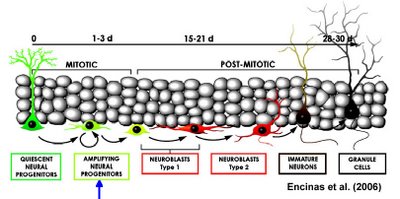Etiology or Epiphenomenon?
Some of what we know so far about hippocampal neurogenesis and depression is listed below (along with a speculation or two by The Neurocritic):
1. In rodents, electroconvulsive shock (ECS -- called ECT in humans, the "T" is for "therapy") is more effective than chronic antidepressant administration in increasing the number of new granule cells in the dentate gyrus region of the hippocampus (Malberg et al., 2000).
SPECULATION: it doesn't seem like those extra new neurons could compensate for the memory impairment observed in humans after ECT.
2. Other bad things that increase hippocampal neurogenesis include traumatic brain injury (TBI), ischemic insults, seizures, and caloric restriction (reviewed in Thomas & Peterson, 2003). We wouldn't want to use any of those as treatments for depression.
3. On the other hand, environmental enrichment (Kempermann et al., 1998) and exercise (Ernst et al., 2006) have been shown to increase neurogenesis. These are generally seen as good things that psychiatrists can recommend to their patients. However, it turns out that neurogenesis is not necessary for mice to obtain the cognitive and anxiolytic benefits of environmental enrichment (Meshi et al., in press).
4. The antidepressants that increase neurogenesis are not limited to those acting through serotonin-mediated pathways (Malberg et al., 2000; Santarelli et al., 2003). The effecive drug classes include selective norepinephrine reuptake inhibitors, SNRIs (reboxetine); tricylclic antidepressants, TCAs, acting to inhibit reuptake of norepinephrine (desipramine) and both norepinephrine and serotonin (imipramine); monoamine oxidase inhibitors, MAOIs (tranylcypromine); as well as selective serotonin reuptake inhibitors, SSRIs (fluoxetine). This has been viewed as an attractive reason for believing that neurogenesis somehow mediates treatment response, since all sorts of drugs produce the effect.
5. It does appear that hippocampal neurogenesis is necessary for the behavioral benefits of fluoxetine in the novelty-supressed feeding task (Santarelli et al., 2003). Although as pointed out by Thomas and Peterson (2003), the mice in that study were not actually "depressed" (i.e., exposed to continued stress before getting Prozac).
The Neurocritic, although by no means an expert on hippocampal neurogenesis and depression (1) , is nonetheless a skeptic, and in good company in the skeptical camp:
Sapolsky RM. (2004) Is impaired neurogenesis relevant to the affective symptoms of depression? Biol Psychiatry 56:137-9.Finally, the newly-generated baby neurons appear to have greater plasticity than their elders, BUT many of them have only a transient existence (Gould et al., 2001). Alas!
Henn FA, Vollmayr B. (2004) Neurogenesis and depression: Etiology or epiphenomenon? Biol Psychiatry 56:146-50.
The concept that decreased neurogenesis might be the cause of depression is supported by the effects of stress on neurogenesis and the demonstration that neurogenesis seems to be necessary for antidepressant action. Data from the animal models tested to date show that decreasing the rate of neurogenesis does not lead to depressive behavior. Furthermore, evidence shows that an effective treatment for depression, transcranial magnetic stimulation, does not alter rates of neurogenesis. On the basis of these findings, it is suggested that neurogenesis might play a subtle role in depression but that it is not the primary factor in the final common pathway leading to depression.
SUMMARY FROM THE NEUROCRITIC: Although it's all very trendy to consider neurogenesis as "The Reinvention of the Self" (see article in SEED), at this stage of the game, it's all very hyberbolic.
References
Ernst C, Olson AK, Pinel JPJ, Lam RW, Christie BR. (2006) Antidepressant effects of exercise: Evidence for an adult-neurogenesis hypothesis? J Psychiatry Neurosci 31:84-92.
Gould E, Vail N, Wagers M, Gross CG. (2001). Adult-generated hippocampal and neocortical neurons in macaques have a transient existence. PNAS 98:10910-17.
Kempermann G, Kuhn HG, Gage FH. (1998). Experience-induced neurogenesis in the senescent dentate gyrus. J Neurosci 18:3206-3212.
Malberg JE, Eisch AJ, Nestler EJ, Duman RS (2000). Chronic antidepressant treatment increases neurogenesis in adult rat hippocampus. J Neurosci 20:9104-10.
Meshi D, Drew MR, Saxe M, Ansorge MS, David D, Santarelli L, Malapani C, Moore H, Hen R (in press). Hippocampal neurogenesis is not required for behavioral effects of environmental enrichment. Nature Neurosci
Santarelli L, Saxe M, Gross C, Surget A, Battaglia F, Dulawa S, Weisstaub N, Lee J, Duman R, Arancio O, Belzung C, Hen R. (2003). Requirement of hippocampal neurogenesis for the behavioral effects of antidepressants. Science 301:805-9.
Thomas RM, Peterson DA (2003). A neurogenic theory of depression gains momentum. Molecular Interventions 3: 441-444.
(1) and, in fact, whose posts on the topic are based on only a recent and cursory knowledge of the literature
Subscribe to Post Comments [Atom]





















